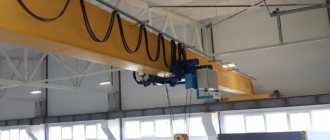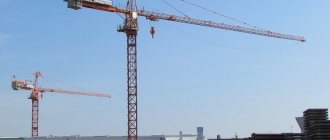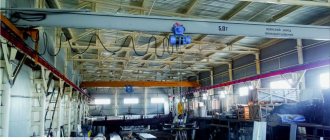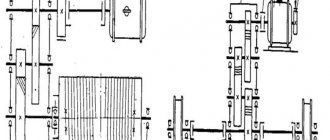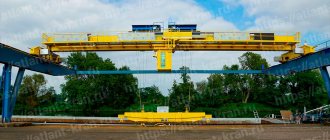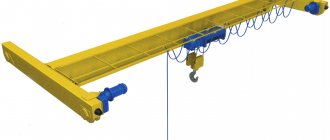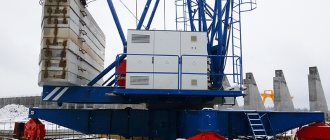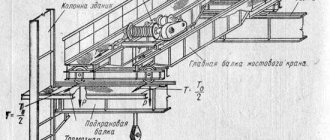Differences in installation of support and overhead cranes
The most noticeable difference between the installation of an overhead support crane and an overhead crane is due to the design of the crane tracks. For an overhead forklift, I-beams are most often used as crane tracks, which are attached to the floors of the building. Such crane tracks allow slight deviations in straightness, since this will be compensated by the design of the wheel block and the movable attachment of the bridge to the end beams.
The support crane requires the mandatory installation of rail tracks installed on special supports. Such a lift is heavier than a suspended one, and its installation is more complex functionally. If the suspended one is more often installed in a full-block way - assembled on the ground and lifted for installation on crane tracks in a fully assembled form, then for the support one the large-block and element-by-element method is more often used - assembling the machine directly on the crane tracks.
Diagram of a single girder overhead crane
Depending on the availability of crane tracks at the site, installation can be:
- partial - if crane tracks already exist, they are checked, then assembled and a crane is installed on them,
- complex - first the crane tracks are installed, then the crane is installed on them.
Accordingly, even a comprehensive installation of an overhead forklift will be cheaper than a support one due to the greater simplicity of the crane runway arrangement. In addition, the choice of installation technology is influenced by the availability of special equipment (self-propelled jib or tower cranes, hydraulic lifts, etc.), the possibility of its placement on the installation site, the configuration of the work area, etc.
Installation of overhead cranes must comply with the requirements of regulatory documentation: GOST (for example, GOST 34589-2019, GOST R 54767-2011), SNiP, RD (for example, RD 10-138-97), PB (for example, PB 10- 382).
Specifications and description
Single-girder overhead cranes are designed to operate in 3 mutually perpendicular planes. These devices are capable of lifting objects weighing up to 320 tons. The load can be moved both along the crane itself and along the working area.
Overhead beam cranes have the following advantages:
- High strength and durability of the structure.
- The lifting mechanism can be used in places with increased seismic activity.
- High speed of transportation of small-sized objects.
Overhead overhead cranes are used for the following operations:
- Carrying out one-time or periodic lifting operations in the absence of current supply.
- Moving loads in open space or inside small closed spaces.
- Carrying out work on the transportation of bulk cargo.
- Moving and lifting objects with magnetic properties.
When operating bridge devices, the following technical parameters of single-girder cranes are taken into account:
- Rise – 0.1–0.3 m/s.
- Bridge movement – 0.1–2.5 m/s.
- Movement with a grab is 0.1–0.8 m/s.
- The trolley stroke is 1–0.8 m/s.
General requirements for the production, storage, acceptance and transportation of overhead girder cranes are specified in GOST 27584-88. Technical parameters for general-purpose electrical single-beam structures are contained in GOST 25711-83, for overhead overhead cranes - in GOST 7890-93.
Budgeting
The estimate includes all types of work that will be required for the complete assembly and installation of the overhead crane, incl. installation work, inspection or leveling of crane tracks, installation of additional structures (mounting masts, etc.), direct assembly and installation of lifting equipment, installation quality control and sea trials.
The amount of the estimate is directly influenced by the crane’s lifting capacity, its design and dimensions, the selected installation technology, the composition of the customer’s fleet of special equipment, the features of the building’s load-bearing structures, the specific conditions of the installation site and other points.
Features of installation of crane tracks
Since the crane runway is the basis of the lifting structure, its high-quality installation is not only complex, but also an important stage in the installation of the crane as a whole.
Features of the crane runway directly depend on the type and individual distinctive characteristics of the lifting equipment. There are the following types of crane runways for overhead cranes:
- a set of crane beams attached directly to the load-bearing structural elements of the room;
- crane runway installed on the supporting columns of the building;
- suspended crane track attached to rafters, reinforced trusses;
In general terms, the installation of crane tracks is as follows:
- A track design is being developed;
- A thorough examination of the proposed installation site is carried out;
- PPR is being developed;
- All necessary metal structure elements and fasteners are supplied;
- Crane beams and rails are installed;
- The crane tracks are being leveled.
Preparatory operations
Before starting installation work, an inspection and study of the installation site is always carried out - a geodetic survey of the crane's working area, a study of the load-bearing capacity of the building's structural elements, the presence or absence of crane tracks. Based on the data obtained and regulatory documentation, a Work Performance Project (WPP) is drawn up, which determines the installation technology, the type of equipment used, and the procedure for carrying out the work.
During complex installation, we install supports and crane tracks, and during partial installation, we carry out a mandatory inspection of their condition and leveling. After drawing up the PPR and estimate, agreeing on these documents with the customer, and completing the preparatory work, the main stage of installation work begins.
A few words about the lifting trolley
This trolley can have a variety of designs, but in any case its main components will certainly be:
- Electric motor.
- Clutch.
- Gearbox.
- Drum with rope
- Hook suspension.
The trolley itself moves along a rail track laid directly along the main beams of the crane. Often one of the drive coupling halves is presented in the form of a shoe-type brake.
Special limit switches are provided as safety elements. One of them ensures an instant stop of lifting the load if the hook suspension reaches the control point. This was done in order to eliminate the possibility of the hook touching the lifting drum with subsequent drilling of the rope. There is also a limit switch that ensures the safe movement of the trolley itself along the crane bridge. Reaching this switch, the cart touches it with a steel ruler, as a result of which it stops completely.
The body of the trolley frame is made from rolled sheets, which are connected to each other by welding and most often bent in the form of a U-shaped profile. The trolley deck is also a steel sheet with existing passages for the rope in the form of special cutouts.
Main stages
In the most general case, the dimensions of the installation site must be at least 2 times the length of the crane bridge, and must allow the placement and assembly of all components of the lifting mechanism.
The overhead crane installation technology includes 3 main options:
- element-by-element - lifting and connecting all parts of the forklift one by one on the crane tracks,
- large-block – assembly of large units on the ground, lifting and joining to the main structure,
- full-block – complete assembly of the lifting device at the zero level, followed by lifting and installation on crane tracks in finished form.
One or another installation method is selected in specific conditions depending on the weight, design and dimensions of the crane, as well as the possibility of using special equipment. Compact cargo lifts with a small lifting capacity (very often suspended) are mounted as a complete block - and lifted onto the crane tracks using a jib crane or using the structures (rafter system) of the building. Massive large lifts are assembled in a piece-by-piece or large-unit manner.
Installation procedure
By the time work begins, the crane parts and assemblies must be delivered to the installation site in working order and ready for installation. The necessary equipment and rigging must also be prepared.
Further assembly and installation are carried out in the following order:
- layout of components in the assembly area, checking completeness in accordance with the design documentation,
- assembly of a cargo lift bridge, installation of electrical equipment, safety devices,
- installation of end beams on crane tracks,
- lifting the bridge and securing it to the end beams,
- checking the quality of installation work,
- power connection, crane testing in static and dynamic mode,
- delivery of the cargo lift to the customer,
- registration with Gosgortekhnadzor (for a load capacity of more than 10 tons).
The operation of the overhead crane is first checked in idle mode, and only after successful testing and running-in of the running and lifting mechanisms, the device is tested with a load.
Lubrication
To fully provide the rubbing parts of the crane with lubricants, both individual and centralized lubrication supply systems are used.
An individual system provides for the lubrication of one individual unit or point, while a centralized system provides for the lubrication of a whole number of parts. The latest version of the lubrication system provides for a station, dosing feeders, lines, and limit switches.
Quality of installation work
Installation of an overhead crane of any type must be carried out only by qualified workers who have undergone special training, experience and appropriate approvals. The quality of work must be strictly controlled at all stages in accordance with regulatory documents.
Required:
- check the compliance of the length of the span beam with the design documentation and the span (distance between crane tracks),
- check the layout of the trolleys and put them on the drawings,
- install crane travel stops on the crane tracks before installation, otherwise it may go off the tracks.
When fastening main structures to each other (for example, bridge beams or a bridge with end beams), they are first fastened with rough bolts, then the geometry of the structure and the diagonals of the crane are checked. After this, they grab the mounting plates, check the geometry again, and after that they fasten them with “clean” bolts and weld the plates.
Strict compliance with the requirements of all regulated technological operations and quality control of their implementation make it possible to ensure high safety and efficiency of the crane throughout its entire design life.
What to pay attention to when installing a faucet
Photo of the installation process. Performed by the company “TehKranMontazh”
High-quality installation of an overhead crane is the key to further uninterrupted and efficient operation of the crane. It is at the time of construction that special attention must be paid, since in this process not only the mechanism itself is laid, but also the basis for its high productivity, as well as the duration of the operational period of the lifting equipment.
Installation work (just like dismantling an overhead crane) should only be carried out by specialists. As a rule, this type of work is carried out by specialized companies that have a documented right to install cranes. Overhead cranes belong to high-risk class mechanisms, so it is extremely important to follow safety precautions both during installation and operation.
The video shows the installation process of a single girder overhead crane
Great importance should be paid to choosing a company that will install lifting mechanisms. Among the main features, it is worth highlighting the presence of all documents permitting installation, configuration and startup of mechanisms, the availability of high-quality special equipment for installation, and a staff of highly qualified specialists with experience in carrying out such work.
Cost of installation work
The specific price is determined by estimate standards and design documentation, and is indicated in the estimate, which is agreed with the customer. It includes all installation costs, including measurements of the installation site and ending with transportation costs. All items in the estimate are justified by technological and regulatory requirements and allow us to obtain lifting equipment of guaranteed high quality. Possible discounts and preferential terms are discussed individually.
To find out the exact cost of installing a crane, send us a request or call +7 (495) 646-86-21
Crane devices with telescopic boom
When unloading covered cars at railway stations, it is most convenient to use beam cranes with a telescopic boom. They consist of:
- from a crane bridge;
- telescopic beam;
- support rollers;
- devices for extending the telescopic boom;
- hook, which is mounted on hinges capable of rotating in all planes.
Very compact jib cranes
To ensure that the extension of the boom does not disturb its support base, the drive with rollers is mounted on an intermediate beam. It is known that telescopic forklifts with inclined crane beams are indispensable in warehouses, railway stations, and ports. Telescopic crane beams, capable of changing the angle of inclination in the range of 0-30 degrees, have become especially popular.
Telescopic loaders are presented on the market in three modifications. They can simultaneously combine three beam cranes. Telescopic forklifts are equipped with a comfortable cabin and a safety system. Some models are capable of lifting loads to a height of up to 18 m. Telescopic loaders are multifunctional; they can be equipped with various attachments - buckets, loading platforms.
